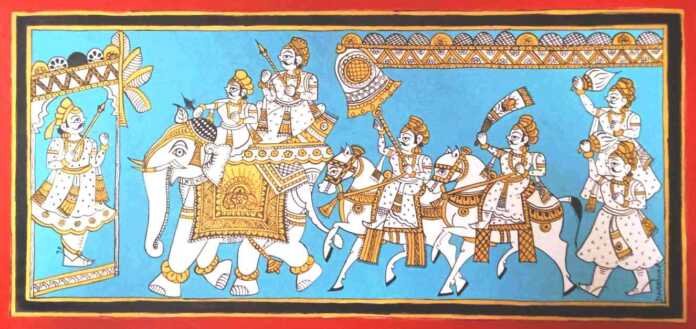Shahpura-Baneda Conflicts were prevailed during seventeenth and eighteenth century A.D. These conflicts were baseless and couldn’t take any shape. When Mewar entered into a treaty of subordination Shahpura-Baneda Conflicts ended without any result.
Mughal Emperors encouraged many younger scions of the Rajput princely houses to establish their own principalities so that the mighty Rajput kingdoms may be divided into small pieces. Mughals granted lands or zamindaris to many Rajput princes which ultimately resulted in the establishment and rise of some new Rajput principalities in Rajputana and Malwa.
Many Sisodia princes of Mewar also joined the Imperial service after the conclusion of the treaty between Mewar and the Mughals in 1615. Raja Sujan Singh and Biramdeo, two sons of Surajmal (the second son of Rana Amar Singh) left Mewar in 1629 and 1640 respectively to join the Mnghal court.[1]
Shahjahan bestowed the paragana of Phulia on Sujan Singh in 1631.[2] Sujan Singh established a new town at Sisola in his paragana and named it Shahpura in honour of the Emperor. Another such able scion of of Sisodias was Raja Bhim Singh, the step brother of Maharana Jai Singh, who joined the Imperial service in 1681, very soon after the treaty which ended the Rajput war between Mewar and Aurangzeb. He was granted the Baneda paragana in the Chitore Sarkar of the Ajmer Suba.[3]
Thus the two off-shoots of the Sisodia family were granted watans in the same area with a common border. From the very beginning these two estates could not pull on well with each other although they belonged to one house. There were constant disputes between the two estates, which on one occasion led to the interference of Mewar. [4]
The first evidence of their mutual jealousy is found in 1688. The Rathore Jagirdars of Shahpura in an act of in-subordination against their chief plundered a village named Bahas. Raja Bharat Singh, the Shahpura ruler marched against them with a large force. He defeated the combined forces of several subordinate Rathore chiefs in an engagement, Raja Sultan Singh the ruler of Baneda, who was standing nearby fled away from the place and force of Shahpura captured their elephants, cannon and horses. It appears that the Raja of Baneda had promised help to the Rathors and was waiting for a suitable opportunity to intervene.[5]
Another difference between the two rulers arose out of the grant of paragana Jahajpur to Bharat Singh. In recognition of his bravery and loyal services, Emperor Bahadur Shah bestowed on him the above Paragana on November 14, 1708,[6]
It was alleged by the Shahpura ruler that Raja Sultan Singh of Baneda had tried to secure Jahajpur for himself by offering a higher price. When Raja Bharat Singh heard about it he offered a still higher bid for Baneda. Such bids came to nothing as both of them were advised by their well wishers to desist from the display of their mutual jealousy in the Mughal court.[7]
With the decline of the central power there was no one to enforce lawful rights and prevent ambitious conflicts between one ruler and another or between the feudal lords. Consequently the strained relations of Baneda and Shahpura began to take a serious turn.
Raja Ummaid Singh, who succeeded to Shahpura Gadi in 1729 A.D., was an extremely capable ruler with unlimited ambition. He naturally coveted his neighbouring principality of Baneda.
In 1734 A.D., a few herds of cattle were driven away by villagers of Baneda estate. This incident provided an excuse to Ummaid Singh for launching an attack on Baneda. According to Shahpura Khyat he made a surprise attack on the fort of Baneda in the night and captured it. Sirdar Singh, the ruler of Baneda, sought the help of Abhaya Singh, the ruler of Jodhpur, who was his brother-in-law. Abhaya Singh proceeded towards Baneda. Ummaid Singh prepared himself for a battle. However, after three days of negotiations he restored the fort to Sirdar Singh. Here it may be stated that the above version of the incident is narrated in Shahpura Khyat [8] while the history of Baneda based on the original records of the estate does not mention it at all. Hence the capture of Baneda by Ummaid Singh remains in doubt although it is believed that the attack might have taken place. [9]
Ummaid Singh continued to harbour the ill-conceived design humiliating Baneda ruler and if possible capture the Baneda principality. On 14 December, 1756 he received an information from his agent at Baneda about the serious illness of the son of Raja Sirdar Singh along with the news of unpreparedness of the Baneda forces. He ordered prince Ran Singh to proceed towards Baneda with an army with specific instruction of picking upA quarrel with Baneda in order to capture the fort.[10]
In the fight which occurred in the night of 16 December 1756, Sirdar Singh was defeated. He managed to escape to Rupaheli, A nereby village and from there went to Udaipur where he wasgiven shelter. Ummaid Singh visited Baneda and in an open Durbar acknowledged the tributes of several subordinate chiefs of Baneda.
Maharana Jag at Singh II promised help to Sirdar Singh on the specific condition of Acknowledgement of supremacy of Mewar by him. He was provided with a small force. In an attack, in which Thakur Shiv Singh of Rupaheli also helped him, Sirdar Singh captured few cattle from Baneda territories.
The action of the Rana in rendering help to Sirdar Singh enraged Raja Ummaid Singh who was already not on good terms with Mewar on account of the dispute over the possession of Jahajpur. He, along with Raw at Jaswant Singh of Deogarh, plundered Mandal, Meja and Bhilwara.[11] A bigger army estimated at about ten thousand, proceeded from Udaipur towards Benada.[12]
They encamped at village Itmarya in Shahpura Area.[13] After a brief skirmish the fort was recaptured by the combined forces of Mewar and Baneda on the night of 2 January, 1757 and restored to Sirdar Singh. The version narrated in the Khyat of o Shahpura[14] that after eleven days of fight between the two forces there were negotiations of three days between the two parties and the fort was restored to Sirdar Singh on the condition that Jahajpur would be handed over to Shahpura by Mewar along with one lakh of rupees can be rejected on the simple ground that between the capture and restoration of the fort only seventeen days had elapsed and in this short period it was not possible for Sirdar Singh to do all the things narrated above. [15]
In the reign of Raja Rai Singh who succeeded Sirdar Singh in 17589 the relations between him and Ummaid Singh were not cordial. although no major conflict took place yet there were numerous cases of disagreement between the two. In 1760, the Raja of Baneda resumed the grant of village Sareri from Naga Piragpuri, who had placed himself under the protection of Raja of Shahpura. The Shahpura ruler strongly protested against the resumption of this Village. He deprecated the use of force by Rai Singh and maintained that Naga Piragpuri was placed under his protection by Jankoji Sindhia.[16]
The differences between the two rulers had their reaction on the peopleAlso. Traders from both the principalities visited Bhilwara for their transactions. It seems that the villagers of Baneda living on the route harrased the traders of Shahpura visiting Bhilwara. Raja Ummaid Singh in a letter of 1762 warned the ruler of Baneda that repetition of such an incident might lead to a conflict for which Baneda would be held responsible.[17]
In 1767 the Raja of Baneda protested against the encroachment made by the men of Shahpura in the forests of Khera and Lasadia villages under his domain. Ummaid Singh denied such allegations. He was, however, mild in his tone this time. In order to avoid tension he requested Rai Singh to instruct his men to remain within their boundary as he had also ordered his men to do so.[18]
In the civil war between Maharana Arsi and Ratan Singh Ummaid Singh joined the camp of Arsi when a handsome offer of the grant of Kachola paragana wasmade to him in 1765.[19] Raja Rai Singh also decided to support Rana Arsi.
Athough both the rulers were in one camp their differences continued. Rai Singh pressed his claim over villages, Itmarya and Karmravas, held by Shahpura. In 1768 RanaArsi after making enquiries promised to get these villages evacuated by Shahpura.[20]
The above resume of the feud between the two principalities represent the state of affairs in Rajasthan during the eighteenth century. With the dismemberment of the Mughal empire many new powerful centrifugal forces raised their heads in the different parts of the country.
Not even caring for the ties of kinship they indulged in internecine disputes and wars with an object to take possession of the border are as of the adjoining states and if possible to conquer the whole of it.[21]
Trivial reasons like the lifting of cattle by the men of other state in border villages or encroachment on waste lands were regarded as a sufficient excuse for starting a conflict. For achieving their selfish ends they even invited the Marathas, with the result that the Deccanis interfered in sm all matters.
As for example in the case of Baneda and Shahpura Jankoji transferred Sareri village from the possession of Baneda to Shahpura. Consequently the Marathas made capital out of such feuds. Such state of affairs proved too much disastrous for the country with the result that “Disorder, public plunder, economic ruin and moral degradation were the chronic condition of Rajasthan from the declining years of Muhammed Shah to the day when the the British suzerainty was accepted by the land”.[22]
REFERENCES
[1] Maasir-Ul-Umra.
[2] Ibid.
[3] Farman issued by Aurangzeb on 28th JULY, 1681-Op. cit.
Baneda Ka Itihas by Chitambre.
[4] DR. L. P. Mathur, Shahpura-Baneda Feud (1681-1769), Rajasthan Hisory Congress, 1968, pp. 69-73.
[5] Shahpura-Ki-Khyat, pp. 12-13.
[6] Ibid., p. 86.
[7] Ibid., p. 97.
[8] Ibid., p. 31.
[9] DR. L. P. Mathur, Shahpura-Baneda Feud (1681-1769), Rajasthan Hisory Congress, 1968, pp. 69-73.
[10] Shahpura-Ki-Khyat, p, 167.
[11] Ibid., p. 168.
[12] Ibid., p. 175.
[13] Vir. Vinod, p. 154.
[14] Shahpura-Ki-Khyat, p. 174.
[15] DR. L. P. Mathur, Shahpura-Baneda Feud (1681-1769), Rajasthan Hisory Congress, 1968, pp. 69-73.
[16] Ibid., p. 185.
[17] Selections form Baneda fort archives Edited by Dr. L. P. Mathur and Dr. K.S. Gupta: Letter from Ummaid Singh to Rai Singh dated 15 Nov. 1760.
[18] Ibid Dated 10 September, 1762.
[19] Ibid Dated 20August, 1767.
[20] Vir Vinod, 1 pp. 551-52.
[21] Selections from Baneda fort archives, letter from Rana Arsi to Rai Singh dated 30 October, 1768.
[22] J. N. Sirkar, Fall of the Mughal Empire, Vol. I, p. 132.




